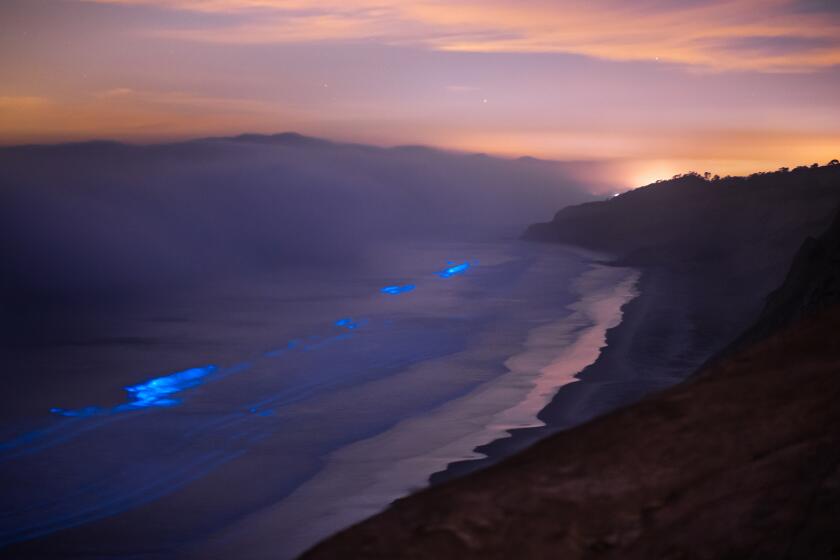Southern California’s bioluminescent waves are back. It may not be too late to see the electric blue nights

- Share via
For more than a week straight, photographers, scientists and adventure seekers alike have captured dazzling images of an electric blue light emitting from Southern California’s waves at night.
The display of bioluminescence, created when a type of algae is agitated, is difficult to forecast, but over the last ten days, Californians have shared videos and photos of the phenomenon from San Diego to Point Mugu and several other locations in between.
There is no guarantee that the spectacle would again occur Wednesday night — or exactly where — but experts said the chances were good.
On Monday night, photographer Patrick Coyne went to Marina del Rey, where he saw the brightest bioluminescent waters he said he’s ever experienced — quite impressive considering he’s been chasing the neon blue waves since 2018.
It “was so unbelievably bright that my iPhone was picking it up more than it ever has,” Coyne, 30, said. He said he’s been out at area beaches most of the last 10 nights documenting waves crashing neon blue, surfers riding along sparkling swells and the water glowing as he waded along the shore.
On Tuesday night, he again saw the “bio” at Venice Beach, he said. Others on social media shared photos from Santa Monica and Dockweiler beaches.
Coyne has amassed a large online following from his striking photos and videos, but also his willingness — and dedication — to find and share when and where the bioluminescent light shows are on display. Once he posts where he’s spotted the electrifying waves, dozens of followers soon join him at the spot, he said.
“I love showing people this phenomenon. … It feels like magic,” he said.
And for those who haven’t yet seen bright blue ocean, it might not be too late. Coyne is planning to again head to the coast once nightfall comes Wednesday.
“We really don’t know; Mother Nature kind of decides when it shows up and when it doesn’t,” said Coyne, who estimated that he’s seen probably 300 occurrences over the last six years.
Patrick Coyne has photographed bioluminescence off the beaches of L.A. and Orange counties since 2019. He shares tips for seeing the magical ocean glow.
But he’s also struck out many more times.
“I have been out hundreds on hundreds on hundreds of times looking for it,” he said. He had high hopes for Tuesday night’s odds — which panned out — and expects the chances are good for Wednesday.
“But I’ve been burned in the past,” he said. “It’s so random.”
Given the intensity of the glow he saw the last two nights and the long streak already recorded, he expects there will still be enough of the microscopic algae that emit the bioluminescent glow — a type of dinoflagellate — to light up waves somewhere along Southern California’s coast. During the day, those dinoflagellates cast a rusty hue across the ocean — often called a “red tide” — which sky cameras on Tuesday captured covering a large area around the Santa Monica Pier.
Rebecca Shipe, an adjunct associate professor at UCLA’s Institute of the Environment and Sustainability, said she estimates the algae bloom causing the neon glow is at or nearing its peak.
“The bioluminescent dinoflagellate ... has had the right conditions of nutrients and sunlight in nearshore waters, to grow to extremely high concentrations,” she wrote in an email. “I’ve taken samples in the last week that had 5 to 20 million cells per liter of seawater, relative to our usual background of 30,000 phytoplankton cells per liter.”
She urged Angelenos to get out and experience this spectacle with their own eyes.
“This bloom is a stunning natural phenomenon that has been fairly rare over the last couple of decades,” Shipe said. “So it’s definitely worth getting down to the beach to view.”
But red tides — and the accompanying bioluminescence — are quite fickle, according to UC San Diego’s Scripps Institution of Oceanography. They can last just one day or many, and their scope can stretch across hundreds of miles or be more localized. Last week, a UC San Diego photographer captured dolphins gliding through blue, glowing waters.
“Previous events have lasted anywhere from one week to a month or more,” according to Scripps researchers. “There is no way to predict how long they will last.”
In 2020, the region saw a particularly long stretch of the spectacle over several weeks.
The dinoflagellates known as Lingulodinium polyedra use bioluminescence to avoid predators by either scaring off hungry sea creatures or calling attention to their location, which draws the predators’ predators, experts have said.
Researchers are still working to better understand how these algae blooms affect ocean life and humans. There’s no public health warning associated with the events, but some people have reported health effects from the red tide.
When the bloom dies off, the dying algae use up much of the water’s surrounding oxygen, Shipe said, which can create dead zones that affect invertebrates and fish.
More to Read
Sign up for Essential California
The most important California stories and recommendations in your inbox every morning.
You may occasionally receive promotional content from the Los Angeles Times.












